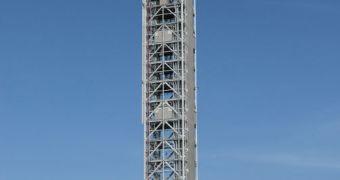Back in 2010, engineers at NASA finished constructing a new mobile launch platform, which was to support the agency's efforts of returning to the Moon by 2020. Now that this is no longer the case, officials are considering to put the platform to use with new delivery systems.
The massive platform was assembled north of the iconic Vehicle Assembly Building (VAB) at the NASA Kennedy Space Center (KSC), in Florida. Called simply the mobile launcher (ML), the support structure includes a base, tower and launch mount, and could easily fit on a Crawler-Transporter.
Officials at the American space agency say that they can think of a multitude of uses for the ML, including the launch of the newly-announced Space Launch System (SLS) heavy-lift rocket NASA is developing. Private rockets are also an option to be considered.
The $500 million (€366.9 million) platform was developed specifically to support the launch of the ARES I rocket, which was at the time part of Project Constellation. But US President Barack Obama canceled the Moon-bound endeavor back in 2010, after only a single prototype rocket was created.
Now that the fate of the Project is sealed, NASA sees no use in keeping the ML confined and out of service. In addition to the SLS, it could serve private rockets such as the ATK/Astrium Liberty vehicle, which could enter service within a few years.
At 390 feet (119 meters) tall, the platform is a remarkable sight to behold. It is also capable of accommodating the needs of a large variety of delivery systems with minimal modifications to the overall structure, KSC engineers say.
“We're looking at using it for SLS, and all those possibilities still are being evaluated,” explains NASA spokesman Allard Beutel, quoted by Space. The space agency is now planning to launch the SLS on its first test flight as early as 2017.
NASA's current goal is to reach a near-Earth asteroid by 2025, and then Mars by the mid-2030s. Both missions need to be manned, and will most likely use the Orion Multi-Purpose Crew Exploration Vehicle (MPCV), a trimmed down version of Project Constellation's original Orion space capsule.
The Orion MPCV will take off aboard the SLS, NASA announced a few days ago. “The basic structure of the tower is in place and could support an SLS rocket,” Beutel adds.
“So, we're looking at the modifications that would be needed to specifically support the SLS and Orion spacecraft, such as the power and propellant umbilicals (pipes, cables, etc.) now that we've announced the SLS architecture,” he concludes.

 14 DAY TRIAL //
14 DAY TRIAL //